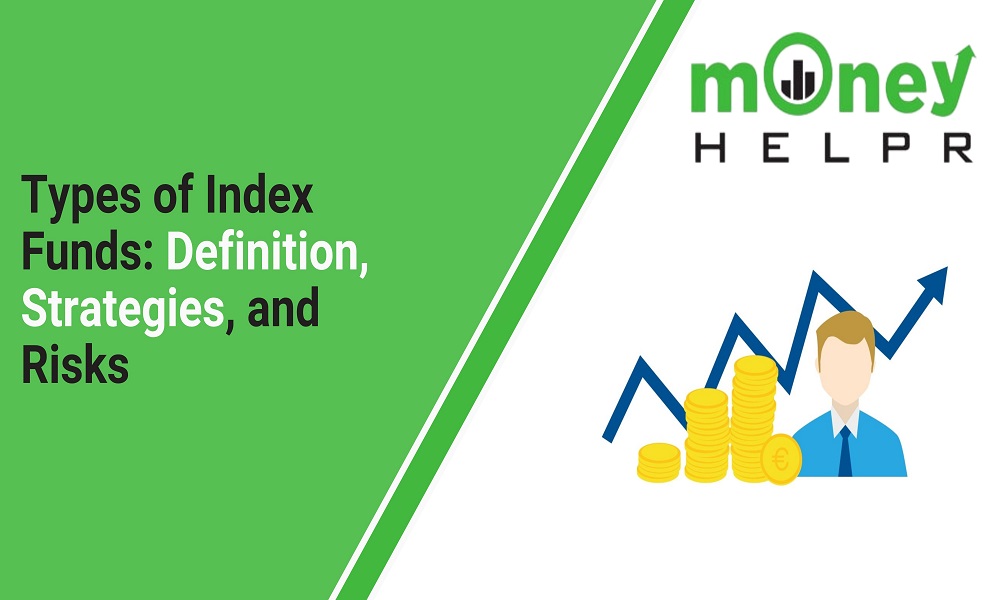Index funds have gained significant popularity among investors as a passive investment strategy. They aim to replicate the performance of a specific market index, providing diversification and a low-cost investment option. In this comprehensive blog post, we will delve into the world of index funds, exploring their definition, various types, investment strategies, risks involved, and their relevance for investors seeking financial guidance on platforms like moneyhelpr.com.
Understanding Index Funds
1. What are Index Funds?
Index funds are investment funds designed to track the performance of a specific market index, such as the S&P 500. They aim to replicate the index’s returns by holding a diversified portfolio of securities that mirror the index’s composition.
2. How Index Funds Work:
Index funds work by investing in the same stocks or bonds as the index they track. Their portfolio composition is based on the index’s weighting methodology, whether market capitalization weighted, equal weighted, or otherwise. The funds aim to deliver returns that closely match the index’s performance.
3. Benefits of Investing in Index Funds:
Investing in index funds offers several benefits, including broad market exposure, diversification, lower expense ratios compared to actively managed funds, tax efficiency, and simplicity. They are suitable for long-term investors seeking steady returns without the need for active portfolio management.
4. Comparing Index Funds to Actively Managed Funds:
Index funds differ from actively managed funds, where portfolio managers aim to outperform the market through stock selection and timing. While active funds can generate higher returns, they often come with higher fees and the risk of underperforming the market. Index funds provide a passive approach that aligns with the overall market performance.
Market Capitalization Weighted Index Funds:
1. Definition and Explanation:
Market capitalization-weighted index funds allocate their holdings based on the market value of the companies included in the index. Larger companies with higher market capitalizations have a higher weight in the fund, influencing its performance.
2. Examples of Market Capitalization Weighted Index Funds:
Popular examples of market capitalization-weighted index funds include the Vanguard 500 Index Fund (VFIAX) and the SPDR S&P 500 ETF (SPY), both of which aim to track the performance of the S&P 500 index.
3. Pros and Cons of Market Capitalization Weighted Index Funds:
Market capitalization weighted index funds offer simplicity, broad market representation, and low turnover. However, they can be heavily influenced by a few large-cap stocks, potentially leading to overexposure to certain sectors or companies.
Equal Weighted Index Funds:
1. Definition and Explanation:
Equal weighted index funds assign an equal weight to each component in the index they track. Regardless of market capitalization, each stock or bond has an equal contribution to the fund’s overall performance.
2. Examples of Equal Weighted Index Funds:
Examples of equal weighted index funds include the Invesco S&P 500 Equal Weight ETF (RSP) and the Guggenheim S&P 500 Equal Weight Technology ETF (RYT).
3. Pros and Cons of Equal Weighted Index Funds:
Equal weighted index funds provide equal representation to all components, avoiding overexposure to specific stocks or sectors. They offer potential for outperformance if smaller companies perform well. However, they may have higher turnover and incur higher trading costs.
Sector Index Funds:
1. Definition and Explanation:
Sector index funds focus on specific sectors of the market, such as technology, healthcare, or energy. They invest in companies within the chosen sector, aiming to replicate the performance of a sector-specific index.
2. Examples of Sector Index Funds:
Examples of sector index funds include the Technology Select Sector SPDR Fund (XLK) and the Health Care Select Sector SPDR Fund (XLV), which track the technology and healthcare sectors, respectively.
3. Pros and Cons of Sector Index Funds:
Sector funds in index allow investors to gain targeted exposure to specific industries. They can be useful for diversifying a portfolio or capitalizing on sector-specific trends. However, they can be more volatile and carry higher risks due to the concentrated exposure within a particular sector.
Bond Index Funds:
1. Definition and Explanation:
Bond index funds track the performance of a bond market index, such as the Bloomberg Barclays U.S. Aggregate Bond Index. These funds invest in a diversified portfolio of bonds, aiming to replicate the index’s returns.
2. Examples of Bond Index Funds:
Examples of bond index funds include the Vanguard Total Bond Market Index Fund (VBTLX) and the iShares Core U.S. Aggregate Bond ETF (AGG).
3. Pros and Cons of Bond Index Funds:
Bond index funds provide exposure to a broad range of bonds, offering diversification and potentially lower risk compared to individual bonds. They also offer transparency and lower fees. However, they are still subject to interest rate and credit risks.
International Index Funds:
1. Definition and Explanation:
International index funds invest in securities from global markets outside the investor’s home country. They aim to replicate the performance of an international market index, such as the MSCI EAFE Index.
2. Examples of International Index Funds:
Examples of international index funds include the Vanguard Total International Stock Index Fund (VTIAX) and the iShares MSCI EAFE ETF (EFA).
3. Pros and Cons of International Index Funds:
International index funds provide exposure to international markets, allowing investors to diversify geographically. They offer broad market coverage and the potential for long-term growth. However, they can be influenced by currency fluctuations and geopolitical risks.
Socially Responsible Index Funds:
1. Definition and Explanation:
Socially responsible index funds, also known as sustainable or ESG (Environmental, Social, and Governance) index funds, invest in companies that meet specific ethical or sustainability criteria. These funds consider factors like environmental impact, social responsibility, and corporate governance practices.
2. Examples of Socially Responsible Index Funds:
Examples of socially responsible index funds include the Vanguard ESG U.S. Stock ETF (ESGV) and the iShares MSCI KLD 400 Social ETF (DSI).
3. Pros and Cons of Socially Responsible Index Funds:
Socially responsible index funds allow investors to align their investments with their values. They promote responsible investing and support companies with sustainable practices. However, the criteria for selecting companies can vary across funds, and there may be a trade-off between social impact and financial returns.
Smart Beta Index Funds:
1. Definition and Explanation:
Smart beta index funds incorporate alternative weighting or factor-based strategies to go beyond traditional market capitalization weighting. These funds aim to deliver enhanced returns or risk management by considering factors like value, volatility, or quality.
2. Examples of Smart Beta Index Funds:
Examples of smart beta index funds include the iShares Edge MSCI USA Value Factor ETF (VLUE) and the Invesco S&P 500 Quality ETF (SPHQ).
3. Pros and Cons of Smart Beta Index Funds:
Smart beta index funds offer a systematic approach that combines elements of active and passive investing. They provide potential for improved risk-adjusted returns and targeted factor exposure. However, they can be more complex than traditional index funds and may have higher expense ratios.
Risks Associated with Index Funds
1. Tracking Error:
Index funds may experience tracking error, which is the deviation of their returns from the index they aim to replicate. Factors such as fees, trading costs, and portfolio composition can cause tracking error.
2. Market Volatility and Downturns:
Index funds are subject to market volatility and can experience declines during market downturns. They may not protect against losses during bear markets or severe market downturns.
3. Lack of Flexibility:
As index funds aim to replicate the index, they lack flexibility in terms of active stock selection or allocation adjustments. They are designed for long-term investment and may not actively respond to changing market conditions.
4. Concentration Risks:
Certain types of index funds, such as market capitalization weighted funds, can have a heavy concentration in a few large-cap stocks or specific sectors. This concentration can expose investors to risks associated with those stocks or sectors.
Conclusion
Index funds offer investors a passive investment approach that provides diversification, low costs, and potential market performance. Understanding the different types of index funds, their strategies, and associated risks is crucial for investors seeking to build a well-rounded investment portfolio. Platforms like moneyhelpr.com offer valuable resources and guidance to help investors navigate the world of index funds and make informed investment decisions aligned with their financial goals. By considering their investment objectives, risk tolerance, and seeking professional advice, investors can leverage the benefits of index funds to achieve long-term financial success.

